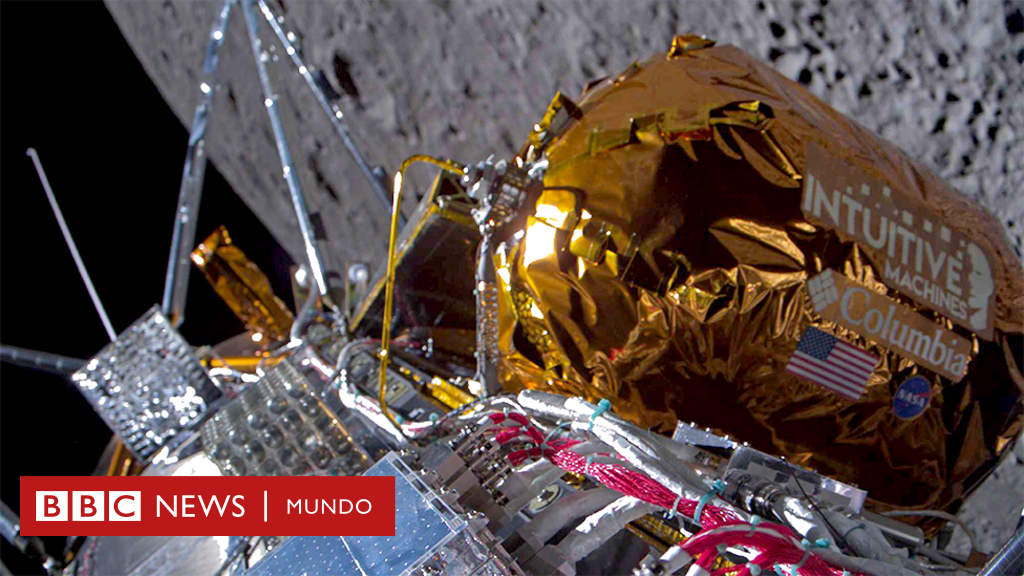image source, Intuitive machines
- author, Draft
- stock, BBC News World
These are the words of Intuitive Machines CEO Steve Altemus following the successful landing of the Odysseus lunar module.
The spacecraft is also known as the Nova-C Lander. touched our satellite on Thursday, A week after release.
“Houston, Odysseus has found its new home,” replied the company's technical director, Tim Crain, amid cheers from operators in the control tower.
The action was broadcast live from there, although communications were lost in the last seconds before landing and it was deemed a failure.
image source, Good pictures
The instinctive mechanical staff erupted with joy when the success of the mission was confirmed.
A historic moon landing
About The first ship built by a private company It landed on the moon and was the first American to do so in more than 50 years, the famous Apollo program and its last mission: Apollo 17 in 1972.
NASA Director Bill Nelson echoed the words of Neil Armstrong, who first set foot on the moon in 1969, saying, “It's a giant leap forward for all of mankind.”
image source, Good pictures
Neil Armstrong, aboard Apollo 11, was the first man to set foot on the moon.
Odysseus was launched on February 9 on a SpaceX Falcon rocket and launched in the following days. A journey of almost a million kilometres Until it reaches the orbit of the moon.
Before landing on the moon, the exact time of the ship's touchdown had to be adjusted several times.
It landed near the crater Malabert A located in the area South Pole Region of the satellite.
Landing on the Moon at that particular location was a significant technical challenge, given the complexity of the descent maneuvers and the precision required to land in an area of scientific interest.
The moon's south pole has long been the focus of scientific interest because its permanently shadowed craters are believed to be rich in frozen water.
A moment of historical significance despite doubts
image source, Good pictures
There were tense moments while waiting for Odysseus' signal.
Analysis by BBC science correspondent Jonathan Amos
We have just witnessed a critical moment not only for the commercial exploitation of space, but for the American space program in general.
Intuitive machines have ended a half-century without the United States from the surface of the Moon. Since the last Apollo mission, no American team has made a soft landing on lunar soil.
The Odysseus space module is unmanned and only a robot, but its planned scientific studies make it a probe for the return of astronauts later this decade.
image source, Reuters
The day before Odysseus lands on his moon.
Now the question we all ask ourselves is: At what stage is this?
It landed softly enough to send it back to Earth, but intuitive machine controllers didn't have the clarity they were hoping for…at least not yet.
Over the next few hours, a picture of the ship's position will emerge as engineers work to decipher signals from the moon.
Mind you, we had to wait two hours for the Japanese space agency to tell us that its slime lander was in a bad state, down and safe.
Odysseus finds himself in a dire situation.
But don't underestimate what just happened. America has gone to the moon again.
Odysseus' double task
Paid by NASA US$118 million For intuitive machines to carry out the operation.
Odysseus can operate for a maximum of seven Earth days, the length of a lunar day before the satellite runs out of power due to nightfall.
image source, Good pictures
Only the United States, the former USSR, China, India and Japan have landed a spacecraft on the moon.
The module carries to the moon NASA science instruments and commercial inventory.
The former can be used to conduct scientific research on the lunar surface, particularly in the South Pole region, which can provide valuable information on other aspects such as lunar geology, soil composition, and radiation environment.
They will also allow it Test new technologies in the lunar environmentFrom landing procedures to scientific instruments and propulsion systems, it will pave the way for future human and robotic exploration missions.
Also, the mission seeks to lay the groundwork for the transportation and use of commercial customer payloads that include communications technology, private scientific experiments, and cultural or promotional devices.
Remember that you can receive notifications from us. Download the latest version of the app and activate them so you don't miss our best content.
Misty Tate
"Freelance twitter advocate. Hardcore food nerd. Avid writer. Infuriatingly humble problem solver."





:quality(85)/cloudfront-us-east-1.images.arcpublishing.com/infobae/KTKFKR763RBZ5BDQZJ36S5QUHM.jpg)